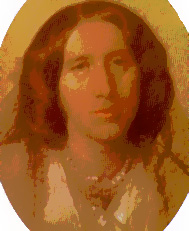George Eliot is the pseudonym of English novelist Mary Ann (or Marian) Evans, later Cross. She was born in 1819 in Warwickshire and at school was influenced by Evangelicalism. When her mother died, she returned to keep house for her father and in 1841, they moved to Coventry. There she was influenced by Charles Bray, a prosperous manufacturer, freethinker and campaigner for radical causes, and by An Inquiry Concerning the Origin of Christianity (1838) by her brother-in-law Charles Hennell. This led to her break with orthodoxy but she remained with her conservative father until he died in 1849.  In 1846, Evans translated D.F. Strauss's The Life of Jesus Critically Examined, which profoundly influenced English rationalism. In January 1851, she settled in London to work as a free-lance writer and became the sub editor of The Westminster Review. In 1854, she began to live with the radical journalist George Henry Lewes who was in an estranged married. Despite the social isolation for Evans, they remained together until Lewes’s death in 1878. Missing the family that now kept apart from her, Evans began writing short stories based on her childhood memories of Warwickshire. These were collectively published in Scenes of Clerical Life, (1858) under the pseudonym George Eliot. When Lewes died, Eliot devoted her time to completing the final volume of his Problems of Life and Mind (1873–79) and founded a Studentship in his honour at Cambridge. In May 1880, she married her investment advisor John Walter Cross and after a wedding trip to Italy, she died in December and was buried in Highgate Cemetery.
In 1846, Evans translated D.F. Strauss's The Life of Jesus Critically Examined, which profoundly influenced English rationalism. In January 1851, she settled in London to work as a free-lance writer and became the sub editor of The Westminster Review. In 1854, she began to live with the radical journalist George Henry Lewes who was in an estranged married. Despite the social isolation for Evans, they remained together until Lewes’s death in 1878. Missing the family that now kept apart from her, Evans began writing short stories based on her childhood memories of Warwickshire. These were collectively published in Scenes of Clerical Life, (1858) under the pseudonym George Eliot. When Lewes died, Eliot devoted her time to completing the final volume of his Problems of Life and Mind (1873–79) and founded a Studentship in his honour at Cambridge. In May 1880, she married her investment advisor John Walter Cross and after a wedding trip to Italy, she died in December and was buried in Highgate Cemetery.
Eliot’s novels developed the use of psychological analysis, which is now characteristic of modern fiction. Her first long novel was Adam Bede (1859). Set in the countryside and attempting to be faithful and realistic in representing everyday life, it retells a story told her as a child of a girl condemned for child murder. It was immensely popular. The Mill on the Floss (1860) is a portrayal of childhood and homage to her favourite brother from whom she was estranged. Silas Marner (1861) is about a miser redeemed by bringing up a child. Historical novels were very much in vogue and Romola (1862–63) is based on Savanarola’s religious scourge of Florence in the 15th century. It is rich with historical detail, studied from the British Museum and from trips to Italy. Felix Holt, the Radical (1866) is inspired by the agitation for political reform. Middlemarch (1871–72) is regarded as Eliot’s masterpiece. It depicts characters from all classes from labourers and farmers to middle class professionals and clergy to the landed gentry. It is has an intricate plot of ordinary lives yet providing contrasts and parallels. Eliot’s final novel Daniel Deronda (1876) has a Jewish hero and the vivid depiction of Gwendolyn Harleth, a woman who marries a sinisterly domineering aristocrat for money.